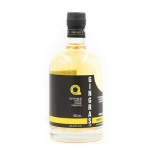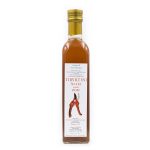
Top Ten Interesting Ways Your Vinegar Can Do More
If you think of vinegar as something which only adorns your leafy salads, it’s time to expand your horizons. Here are a few uses for vinegar which go beyond the vinaigrette.
Brighten up your cooking
Add a tablespoon or two of vinegar to your cooked lentils, stew or soup for a burst of flavor and acidity. Start with: Capirete 20 Year Sherry Vinegar for tomato soup, Gar Rioja Vinegar with black lentils and tomatoes or Gingras Apple Cider Vinegar in beef stew.
Deglaze for great sauces
Use vinegar to deglaze your pan for a flavorful, tangy sauce. Start with: Sweet Cava Vinegar for fish, Capirete Sweet PX Vinegar for red meat, Gingras Balsamic-Style Cider Vinegar for pork or Banyuls Vinegar for greens and other vegetables.
Marinate your meat
Many vinaigrette recipes work wonders as a meat marinade. Ask for a copy of our vinaigrette recipes and use them to marinate or sauce your preferred source of protein. Start with: Spanish Smoke Vinaigrette or Fabulous French Vinaigrette for chicken or Pumpkin Butter Vinaigrette or Cider Vinaigrette for pork.
Reduce it to a glaze or gastrique
A simple glaze can be made by reducing the vinegar by half and then stirring in some honey until combined. A gastrique also starts out by reducing the vinegar by half, then adding some stock, reducing the liquid further and then stirring in fruit or preserves. Start with: Katz Zinfandel Vinger/honey glaze for over fruit, cheese, lamb or beef, or Katz Zinfandel Vinegar/plum preserve gastrique for duck breast.
Drink a dose
A squeeze of fresh lemon juice adds a touch of flavor and acidity to your water, but a splash of
vinegar will take things to another level. Try pouring a tablespoon of your favorite vinegar into a glass of sparkling water, with or without simple syrup to sweeten it up. Start with: Acetorium Fig Vinegar, Allure Raspberry Syrah Vinegar or Katz Sauvignon Blanc Vinegar.
Bake a vinegar pie
We seem to have lost the tradition of vinegar pies, but that doesn’t mean our modern palates can’t appreciate them. Ask for a copy of our recipes for Balsamic Vinegar Pie or Cider Vinegar Pie and make your next baked good the talk of the town. Start with: Vecchia Dispensa Balsamic Vinegar (8 year profile) or Katz Gravenstein Apple Cider Vinegar.
Enjoy it straight up
Sometime vinegar is best on its own. A nice, viscous vinegar with lower acidity doesn’t need to be reigned in. Start with: Vecchia Dispensa Balsamic Vinegar (16, 20 or 30 year profiles) over parmigiano reggiano cheese, beef carpaccio or dark chocolate and berries, Rozendal Fynbos Vinegar over cooked meats or fish or Rozendal Hibiscus Vinegar drizzled over fruit or sipped as an after dinner digestif.
Mix up a ‘shrub’
Colonial Americans preserved fruit in a syrup called a shrub which was made of fruit, sugar & vinegar. The shrub adds flavor and acidity to alcoholic and non-alcoholic beverages and can stay in the fridge for up to a year. Mix your shrub with seltzer water, wine, ginger ale or liquor.
Recipe for about 3 cups of shrub
 Mix 1 cup washed, crushed fruit and 1 cup sugar in a large bowl. Cover and let sit in the fridge until the juice leaves the fruit and mixes with the sugar to form a syrup. This may take hours…or days. (Plan ahead!) Once the syrup is formed, strain the fruit out and whisk in 1 cup of vinegar. Transfer to a clean bottle. Label and date it, sticking it in the fridge for about a week or until the sugar is completely dissolved.
Mix 1 cup washed, crushed fruit and 1 cup sugar in a large bowl. Cover and let sit in the fridge until the juice leaves the fruit and mixes with the sugar to form a syrup. This may take hours…or days. (Plan ahead!) Once the syrup is formed, strain the fruit out and whisk in 1 cup of vinegar. Transfer to a clean bottle. Label and date it, sticking it in the fridge for about a week or until the sugar is completely dissolved.
Get creative with your combinations
Start with: Vecchia Dispensa Balsamic Vinegar (6 year profile)/cherry shrub, Txacoli Orduña Vinegar/peach shrub or Forvm Cabernet Sauvignon Vinegar/raspberry shrub.
Sautéed Sole with Cava Vinegar Sauce
from ‘Guide to Good Eating’ by Ari Weinzweig pg. 90
Ingredients: |
- 3 tbsp capers, preferably packed in salt (1 oz)
- 4 fresh sole fillets, 2-3 oz each
- 1 tbsp extra virgin olive oil
- 2 tbsp Cava vinegar
- coarse sea salt & freshly ground black pepper to taste
If you’re using salted capers, soak them in a bit of warm water for 20 to 30 minutes, changing the
water halfway through. Drain the water, rinse the capers, and dry them on a paper towel.
Season the sole fillets with salt and pepper. Heat the olive oil in a heavy sauté pan over medium high
heat. Add the sole and cook for 1 minute, then turn and cook for 1 to 2 minutes more, until just done. Slide the fish out onto warm plates and leave the pan on the heat. Deglaze by quickly adding the vinegar and the capers to the hot pan. The vinegar will bubble furiously. Use a spatula to scrape down the sides of the pan and collect the bits and pieces of fish that are left behind. Pour over the fish and serve hot.



